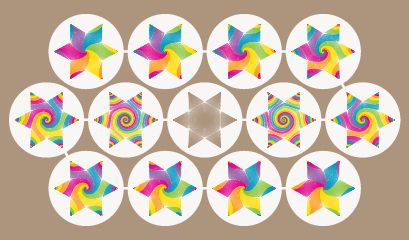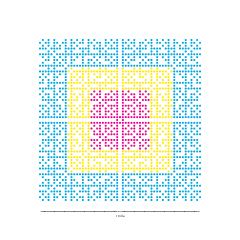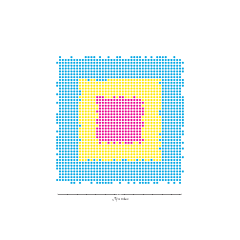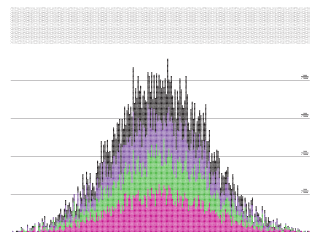Computer science
Typomatic
The Markov machine model is a simple model of computation which is equivalent in power to the Turing machine model, and gives the same time complexity classes modulo P. Typomatic is a cute, colorful, and bizarrely addictive tool for watching Markov machines at work. I’ve had great luck, and great fun, using Typomatic as a hands-on way of introducing middle through high school students to the idea of computability.
Probability
Visualizing neutral theory

These interactive slides use 1d voter models to illustrate basic features of neutral theory—a vision of how genetic and ecological diversity can emerge even without selective pressure. The slides show how questions about the persistence and spatial organization of lineages can be rephrased, in these models, as questions about random walks.
Geometry
Quasiperiodic prints from triply periodic blocks

Slice a triply periodic wooden sculpture along an irrational plane. If you ink the cut surface and press it against a page, the pattern you print will be quasiperiodic. Patterns like these help physicists see how metals conduct electricity in strong magnetic fields. These interactive slides explore the printing process described above and sketch its connection to the physics of conductivity.
Pinwheel

You can think of a translation structure as a pinstripe suit for a Riemann surface. These drawings show variations on a suit for a twice-punctured surface of genus two, sewn from six bolts of colored cloth. They placed in UT Austin's Visualizing Science contest for 2015.
Focal
The long and short radii a and b of an ellipse lie on the hyperbola
a2 – b2 = f2, where f is half the
distance between the foci.
Weighted affine midpoint maps
At a conference, Ren Yi asked whether you can modify the midpoint map to get irregular polygons as attracting fixed points. For the affine midpoint map, this sketch shows that the answer is clearly yes, but I don’t know how to prove it. I also don't know which polygons you can get.
Footprints of π
To celebrate the “π day of the century” in 2015, UT's Physics Mathematics Astronomy Library held a small online exhibit of π-related art. I contributed documentation of two cases in which π appeared under unusual circumstances, with unknown designs. I would like to continue this documentation project, and I encourage anyone with knowledge of similar visitations to contact me.
Each record has been formatted in two ways: as a web page and as a (hopefully) print-ready PDF. See the web page for companion text not shown in the PDF, and the PDF for detail not visible in the web images.


